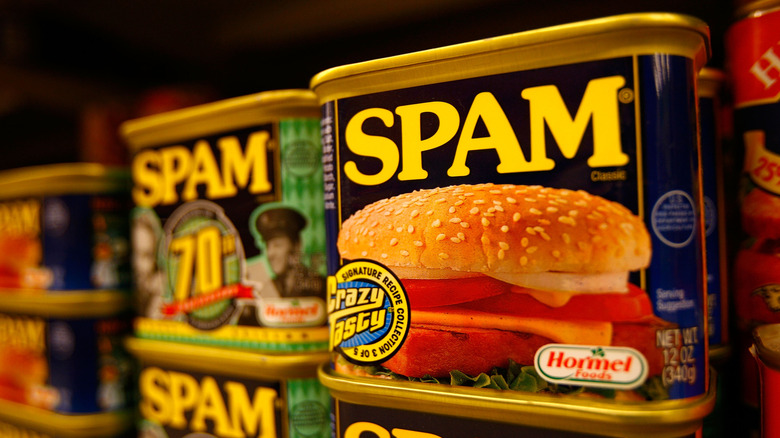Why Is Spam Made In That Distinct Rectangular Shape?
You could probably spot this iconic canned meat a mile away, if only for its distinctive rectangular shape and bright yellow name proudly plastered across. But the shape of Spam is no accident; the recognizable block form comes from a combination of efficiency, practicality, and tradition.
The shape of Spam is truly a marker of its history. Hormel Foods first introduced the canned meat in 1937 during the Great Depression as a way to use up less desirable pork shoulder. Spam was a modern food marvel at the time; it was one of the few shelf-stable canned meats out there. With that kind of competitive advantage, Hormel went heavy on the advertising, pushing its versatility and ease of preparation to homemakers.The rectangular slab of Spam could be kept whole and treated like a roast or sliced into planks for sandwiches, appetizers, and breakfast plates.
Spam went international during World War II thanks to the United States government purchasing large quantities of it to provide much-needed food supplies to both American soldiers and allies abroad. Its rectangular shape proved to be a boon, as it saved on shipping space and was crucial during wartime, as storage on ships and trucks was at a premium. By 1945, U.S. troops stationed in Europe and the Pacific were consuming 65% of all Hormel foods. The craving for Spam has remained strong in areas that had a significant United States military presence, such as Hawaii, South Korea, and the Philippines.
Spam's rectangular shape is here to stay
The lunchmeat's distinctive rectangular shape has other benefits, too. The cans containing a precooked meat mixture of pork with ham, water, salt, potato starch, sugar, and sodium nitrate can be easily stacked and heated at once. In fact, 66,000 cans are able to be heat-treated in one go in a cooker that is six stories tall.
Spam hasn't had too many innovations since. There was the addition of potato starch in 2009, which was added purely to soak up the natural gelatin layer that made some people queasy upon popping open a can. There are also a handful of new types of Spam in flavors like maple and gochujang to keep things interesting.
Though Spam's popularity has certainly ebbed and flowed since its 1937 debut, the potted meat isn't going to pot anytime soon. Its devoted fan base spans nations, and there are even food festivals that continue to celebrate its cultural impact, quirky appeal, delicious flavor, and the many dishes it has inspired. No longer a punchline, Spam has been featured at Brooklyn hipster restaurants, embraced by James Beard Award-winning chefs, and even appeared on an episode of Top Chef. Spam's unique shape, once a necessity for military transport, is now a key part of its brand identity and forever iconic status.

